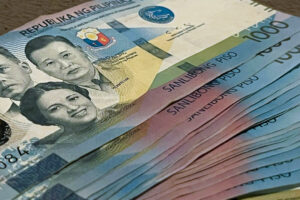Peso may trade sideways amid fresh concerns over US tariffs
THE PESO may continue to trade at the P57 to P58 levels this week as markets await clarity regarding US President Donald J. Trump’s tariff policies. The local unit closed at P58.03 per dollar on Friday, strengthening by 15 centavos from its P58.18 finish on Thursday, Bankers Association of the Philippines data showed. This was […]

THE PESO may continue to trade at the P57 to P58 levels this week as markets await clarity regarding US President Donald J. Trump’s tariff policies.
The local unit closed at P58.03 per dollar on Friday, strengthening by 15 centavos from its P58.18 finish on Thursday, Bankers Association of the Philippines data showed.
This was the peso’s best close in more than a month or since its P57.91-per-dollar finish on Jan. 2.
Week on week, the local unit rose by 33.5 centavos from its P58.365 close on Jan. 31.
“The peso closed stronger on higher jobless rate data from the US… The dollar weakened against most currencies, which was tracked by the local market. However, there was some market caution ahead of the US manufacturing data. Trading volume was also lower,” a trader said by phone on Friday.
Hawkish signals from the Bank of Japan also dragged the dollar down against most Asian currencies on Friday, Rizal Commercial Banking Corp. Chief Economist Michael L. Ricafort said in a Viber message.
For this week, the trader said markets will continue to monitor developments in the Trump administration’s trade policies.
The trader sees the peso moving between P57.80 and P58.30 against the dollar this week, while Mr. Ricafort expects it to range from P57.70 to P58.20.
The dollar rose in choppy trading on Friday after data showed that US job growth slowed in January but that the unemployment rate edged down to 4%, giving the US Federal Reserve cover to hold off cutting interest rates until at least June, Reuters reported.
The US currency was also boosted by comments from Mr. Trump that he plans to announce reciprocal tariffs on many countries this week, without specifying which countries.
The dollar index, which measures the US currency against the yen, sterling and other peers, was last up 0.353% at 108.04. It was on track for a weekly fall after investor fears about a global trade war receded.
Nonfarm payrolls increased by 143,000 jobs last month after rising by an upwardly revised 307,000 in December, the Labor department’s Bureau of Labor Statistics said in its closely watched employment report.
Economists had expected the survey to show 170,000 jobs added.
Investor nerves about global trade wars returned on Friday after Mr. Trump pledged to impose more tariffs as part of a broad effort that he said could also help solve US budget problems.
Mr. Trump made the announcement during a meeting with visiting Japanese Prime Minister Shigeru Ishiba. He said auto tariffs remained on the table amid reports that the White House was weighing potential exemptions.
The dollar fell 0.09% against the yen to 151.365 after falling below 151 yen for the first time since Dec. 10 in early Asian trade on bets that the Bank of Japan will raise rates more than previously expected this year, supported by wage data earlier last week.
Adding to the higher rate expectations were comments by Bank of Japan board member Naoki Tamura, one of the board’s most hawkish members, who said on Thursday the central bank must raise rates to at least 1% in the latter half of fiscal 2025.
The early days of the Trump administration have kept investors on edge. Mr. Trump last week suspended planned tariff measures against Mexico and Canada at the last minute, but imposed additional 10% levies on imports from China, which quickly announced measures of its own on US imports. — AMCS with Reuters


















